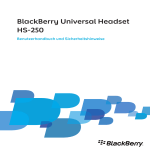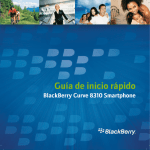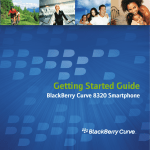Download BlackBerry HS-250
Transcript
BlackBerry Universal Headset
HS-250
User Guide and Safety Information
MAT-53173-001 | PRINTSPEC-021
SWD-2019636-1030095234-001 |
Contents
Getting started...................................................................................................................................................................................................
Components.......................................................................................................................................................................................................
Safety information..............................................................................................................................................................................................
Pairing the headset.............................................................................................................................................................................................
Using the headset...............................................................................................................................................................................................
LED notifications.................................................................................................................................................................................................
Troubleshooting.................................................................................................................................................................................................
2
2
2
3
3
5
6
Safety and product information.........................................................................................................................................................................
Important safety information.............................................................................................................................................................................
Electrical safety..................................................................................................................................................................................................
Battery safety and disposal................................................................................................................................................................................
Audio safety guidelines......................................................................................................................................................................................
Device disposal...................................................................................................................................................................................................
Safe use guidelines.............................................................................................................................................................................................
Drive safely!........................................................................................................................................................................................................
Accessories.........................................................................................................................................................................................................
Antenna care......................................................................................................................................................................................................
Operating and storage temperatures.................................................................................................................................................................
Interference with electronic equipment............................................................................................................................................................
Dangerous areas.................................................................................................................................................................................................
US Information Concerning the Federal Communications Commission ("FCC") Requirements for Hearing Aid Compatibility with Wireless
Devices...............................................................................................................................................................................................................
Service................................................................................................................................................................................................................
Additional safety guidelines...............................................................................................................................................................................
Compliance information.....................................................................................................................................................................................
Product information...........................................................................................................................................................................................
8
8
9
9
10
10
10
11
11
11
11
12
12
Legal notice........................................................................................................................................................................................................
18
13
13
14
14
17
User Guide and Safety Information
Getting started
Getting started
Components
Safety information
Before you get started, please read the safety and operation instructions in this guide before using the BlackBerry
Universal Headset or any accessories provided with the headset. Keep this guide in a safe place so that you can refer to it
whenever you need it.
The headset uses 128-bit encryption software. In some countries there may be restrictions on using Bluetooth enabled and
wireless devices with encryption software. Check with your local authorities for the restrictions in your area.
> Important: In some countries, regions, states, or provinces there might be restrictions on the use of any mobile devices while
driving. You are responsible for knowing and complying with the local laws and regulations in the area that you use the
headset.
To find the latest safety and product information, visit www.blackberry.com/go/docs.
2
Getting started
User Guide and Safety Information
Pairing the headset
Pair and connect the headset with your BlackBerry device
Before you can use your headset, you need to pair it with your BlackBerry device. When you turn on the headset for the first
time, it's already in pairing mode.
1. Slide the power switch on your headset to the On position.
2. On the Home screen of your BlackBerry device, go to the Bluetooth settings.
• For devices running BlackBerry Device Software 7.0 or later, click
Manage Connections icon > Networks and connections > Bluetooth Connections > Turn Bluetooth On > Add New
Device > Search.
3. Click BlackBerry HS-250.
4. If you receive a prompt to enter a passkey, type 0000 on your BlackBerry device.
5. Press the
key on the keyboard.
If you are disconnected, you can press and hold the Call control button for 5 seconds to turn on pairing mode at any time.
To turn off the prompt that appears on your BlackBerry device when connecting and pairing, press the Menu key > Device
Properties and set the Trusted field to Yes. For more information, click the Help icon on the Home screen of your BlackBerry
device.
For information about how to pair a third-party Bluetooth enabled device with your headset, see the help that came with that
device.
To pair your headset with an additional device, press and hold the Call control button for 5 seconds and complete the pairing
procedure above.
Using the headset
Call tasks
You can complete the following call tasks when your headset is paired and connected with your device.
Action
Call control button
Make a call
Press and hold until you hear 1 beep. Say a voice command.
Answer a call
Tap 1 time
Answer a second call
Tap 1 time
3
Getting started
User Guide and Safety Information
Action
Call control button
Return to the first call or switch between calls
Press and hold until you hear 1 beep.
Join two calls
Press and hold until you hear 2 beeps.
End a call
Tap 2 times
Turn on mute
Tap 1 time
When mute is turned on, your headset beeps periodically.
Turn off mute
Tap 1 time
Ignore a call
Tap 2 times
Redial the last phone number
Tap 2 times
Common tasks
Action
Call control button
Turn on pairing mode
Press and hold for 5 seconds.
Cancel pairing mode
Tap 1 time
Clear pairing list
Press and hold for 8 seconds while sliding the power switch to
the On position.
Voice confirmations
Your headset helps confirm the actions you've completed with short statements (in English) that you hear through your
headset.
4
Action
Voice confirmation
Turned on mute
"Muted"
Turned off mute
"Unmuted"
Switched between 2 calls
"Call swapped"
Redialed a phone number
"Redialing last number"
Ended a call
"Call ended"
Bluetooth® connection is no longer active
"Disconnected"
Battery power level is below 10%
Battery low"
User Guide and Safety Information
Getting started
Charge the headset
Your headset comes partially charged and ready for use. When the battery power level is low you hear a voice prompt (in
English) that says "Battery low".
1. Connect the small end of the micro-USB cable or a car charger to the charging port on the headset.
2. Do one of the following:
• Connect the large end of the micro-USB cable to a USB power plug or the USB port on your computer.
• Plug the car charger into your car's power outlet.
Change the earpiece
Try different combinations of the ear gels and the ear hook to find your best fit.
1. If necessary, gently pull the ear hook to remove it.
2. Gently pull off the ear gel at its edges.
3. Replace the ear gel with a new ear gel.
LED notifications
Red LED
Slow flashes: microphone is muted
Quick flashes: not connected to the device
Quick flashes, followed by a pause: battery power level is low
5
User Guide and Safety Information
Getting started
Blue LED
Flashing: connected to a call
1 slow flash: turned on and connected to your device
2 quick flashes: incoming call
5 quick flashes: reconnecting with the last device you paired with
Blue and red LED
Ready for pairing
Green LED
Flashing: turning on or charging
Solid: fully charged
Troubleshooting
I can't connect the headset with my device
You might have accidentally deleted the pairing options that you set for your headset. Complete the steps for connecting and
pairing your headset with your BlackBerry device.
I can't hear anything when I use my headset
Try the following actions:
•
•
Turn up the volume on your BlackBerry device.
Make sure that your headset is turned on and is connected to your device.
I hear static noise when I use my headset
The headset is designed to be used within 10 meters (33 feet) of your device, without any large objects in between.
Try the following actions:
6
User Guide and Safety Information
•
•
Getting started
Move away from any large objects that might cause interference.
Keep your headset on the same side of your body as your device.
7
User Guide and Safety Information
Safety and product information
Safety and product information
Important safety information
Tip
Description
Before you use your BlackBerry Universal Headset, it is important that you read the compliance
information and the guidelines for the safe use of your headset that are found in this guide.
Use only Research In Motion approved chargers. Use of chargers that have not been approved by RIM
might present a risk of fire or explosion, which could cause serious harm, death, or property loss.
Do not rely on your headset for emergency communications.
Do not disassemble your headset. Your headset contains small parts that might be a choking hazard.
Keep your headset away from medical devices, including pacemakers and hearing aids, as they might
malfunction causing serious harm or death to you or others.
Do not put your headset in contact with liquids as this might cause a short circuit, a fire, or an electric
shock.
Driving a vehicle requires your full attention to road conditions, weather, and vehicular traffic. It is
important to set up your BlackBerry Universal Headset prior to driving. Using this hands-free accessory
may cause you to be distracted and may put you, your passengers, and occupants of other vehicles at risk
of suffering bodily injury, death and/or loss of property. You should only use the hands-free accessory
where permitted by law and when you will not be distracted from the proper operation of your motor
vehicle.
Do not use your headset in the presence of gas fumes as it might present a risk of fire or explosion.
Do not use or store your headset in temperatures that exceed 113° F (45°C) as the headset might become
hot.
Do not dispose of your headset device in a fire as this might cause an explosion resulting in serious injury,
death, or property loss.
Turn off your headset in aircrafts. Using your headset on an aircraft might affect aircraft instrumentation,
communication, and performance; might disrupt the network; might otherwise be dangerous to the
operation of the aircraft, its crew, and its passengers; and might be illegal.
8
User Guide and Safety Information
Tip
Safety and product information
Description
The headset is not inherently safe and cannot be used in the presence of explosive fumes, explosive dust,
or other explosive chemicals. Sparks in such areas could cause an explosion or fire resulting in serious
injury, death, or damage to property.
Electrical safety
Charge the BlackBerry Universal Headset using only the vehicle power adapter provided or other charging accessory provided
or specifically approved by Research In Motion Limited (RIM) for use with this headset. Any approval from RIM under this
document must be in writing and must be from a person authorized to provide such approval. Use of any other accessory
might invalidate any warranty provided with the headset and might be dangerous.
Use the charging accessories provided with the headset or any other RIM approved charging accessories only from the type of
power source indicated on the marking label. Before using any power supply, verify that the mains voltage is in accordance
with the voltage printed on the power supply.
Do not overload power outlets, extension cords, or convenience receptacles as this might result in a risk of fire or electric
shock. To reduce the risk of damage to the cord or the plug, pull the plug rather than the cord when you disconnect the
charging accessory from the power outlet or convenience receptacle.
Protect the power cord from being walked on or pinched, particularly at plugs, convenience receptacles, and the point where
the power cord connects to the headset. Unplug charging accessories during lightning storms or when unused for long periods
of time.
Do not use charging accessories outside or in any area exposed to the elements.
For more information about connecting to the power supply, see the instructions in this guide.
Battery safety and disposal
The BlackBerry Universal Headset contains a non-removable lithium-polymer battery. Charge the battery with only the
approved BlackBerry charging accessories. Do not attempt to remove the battery. Do not dispose of the headset in a fire, as
the battery might explode. Dispose of the headset in accordance with the laws and regulations in your area governing disposal
of lithium-polymer cell types.
The lithium-polymer battery might present a fire or chemical burn hazard or might explode if mistreated. Do not disassemble,
crush, or puncture the lithium-polymer battery. Do not heat the lithium-polymer battery above 140°F (60°C).
9
Safety and product information
User Guide and Safety Information
Audio safety guidelines
If you use your BlackBerry Universal Headset at the maximum sound level over
an extended period, hearing impairment might occur.
Research In Motion guarantees compliance with the maximum sound power of
its headset as determined by relevant regulatory bodies.
Audio files: The headset can play audio files. When you listen to audio files using a headset, permanent hearing loss might
occur if you use the headset at a high volume. Avoid increasing the volume of your headset to block out noisy surroundings. If
you experience ringing in your ears or muffled speech, consult a physician to have your hearing checked.
Device disposal
The BlackBerry Universal Headset should not be placed in household waste bins. Please check
local regulations for information about the disposal of electronic products in your area.
Safe use guidelines
•
•
•
•
•
10
Do not place heavy objects on the BlackBerry Universal Headset.
Do not attempt to modify or service the headset.
Do not attempt to cover or push objects into openings on the headset unless instructed to do so in the documentation
supplied by Research In Motion.
Do not force the headset into your ear as forcing it too far or too hard might present a risk of damage to your ear.
Do not use the headset if you have a wound or other irritation on or inside your ear as this may exacerbate your wound or
pre-existing condition.
Safety and product information
User Guide and Safety Information
Drive safely!
WARNING: Driving a vehicle requires your full attention to road conditions, weather, and vehicular traffic. It is important to set
up your BlackBerry Universal Headset prior to driving. Using this hands-free accessory may cause you to be distracted and may
put you, your passengers, and occupants of other vehicles at risk of suffering bodily injury, death and/or loss of property. You
should only use the hands-free accessory where permitted by law and when you will not be distracted from the proper
operation of your motor vehicle.
If your vehicle is equipped with an air bag, do not place the headset or other objects above the air bag, or in the air bag
deployment area. If in-vehicle wireless equipment is improperly stored or installed, and the air bag inflates, serious injury could
result.
Radio frequency (RF) signals might affect improperly installed or inadequately shielded electronic systems in motor vehicles.
Check with the manufacturer or its representative regarding your vehicle. If any equipment has been added to your vehicle,
you should also consult the manufacturer of that equipment for information on radio frequency signals.
Accessories
Use only those accessories approved by Research In Motion. Using any accessories not approved by RIM for use with this
particular BlackBerry Universal Headset model might invalidate any approval or warranty that is applicable to the headset,
might result in the non-operation of the headset, and might be dangerous.
Antenna care
Use only the supplied integrated antenna. Unauthorized antenna modifications or attachments could damage the BlackBerry
Universal Headset and might violate U.S. Federal Communications Commission (FCC) regulations.
Operating and storage temperatures
Place the BlackBerry Universal Headset or BlackBerry Universal Headset accessories away from heat sources, such as radiators,
heat registers, stoves, or other apparatus (including amplifiers) that produce heat. If you are not going to use the headset for
more than 2 weeks, turn off the power.
Follow the operating and storage temperatures listed below:
headset operating
32 to 113°F (0 to 45°C)
OPERATING OUTSIDE OF THIS TEMPERATURE RANGE CAN IMPAIR AUDIO QUALITY AND CAUSE BATTERY DAMAGE.
11
Safety and product information
User Guide and Safety Information
headset storage
14 to 113°F (-10 to 45°C)
STORING OUTSIDE OF THIS TEMPERATURE RANGE CAN CAUSE BATTERY DAMAGE.
Interference with electronic equipment
Most modern electronic equipment is shielded from radio frequency signals. However, certain electronic equipment might not
be shielded against the radio frequency signals from the BlackBerry Universal Headset.
Pacemakers: Consult a physician or the manufacturer of your pacemaker if you have any questions regarding the effect of
radio frequency signals on your pacemaker. If you have a pacemaker, verify that you are using the headset in accordance with
the safety requirements associated with your particular pacemaker, which might include the following requirements:
• Always keep the headset more than 7.88 in. (20 cm) from the pacemaker when the headset is turned on.
• Do not carry the headset in your breast pocket.
• If you have any reason to suspect that interference is taking place, turn off the headset immediately.
Hearing aids: Some digital wireless devices may interfere with some hearing aids. In the event of such interference, consult
your wireless service provider or contact the manufacturer of your hearing aid to discuss alternatives.
Other medical devices: If you use any other personal medical device, consult the manufacturer of your device to determine if
the device is adequately shielded from external radio frequency energy. Your physician may be able to assist you in obtaining
this information.
Health care facilities: Turn off Bluetooth technology on the headset in health care facilities when any regulations posted in
these areas instruct you to do so. Hospitals or health care facilities may be using equipment that could be sensitive to external
radio frequency energy.
Aircraft: Federal Aviation Administration (FAA) and Federal Communications Commission (FCC) regulations prohibit using the
radio of wireless devices while in the air. Turn off the headset before boarding an aircraft. The effect of using Bluetooth
technology on the headset in an aircraft is unknown. Such use might affect aircraft instrumentation, communication, and
performance, might disrupt the network, might otherwise be dangerous to the operation of the aircraft, and might be illegal.
Dangerous areas
The BlackBerry Universal Headset is not an intrinsically safe device and is not suitable for use in hazardous environments,
where such devices are required, including without limitation, in presence of gas fumes, explosive dust situations, operation of
nuclear facilities, aircraft navigation or communication services, air traffic control, and life support or weapons systems.
Potentially explosive atmospheres: Turn off the headset when in any area with a potentially explosive atmosphere, and obey
all signs and instructions. Sparks in such areas could cause an explosion or fire resulting in bodily injury or even death.
12
User Guide and Safety Information
Safety and product information
Areas with a potentially explosive atmosphere are often, but not always, clearly marked. They include fueling areas such as
gasoline or petrol stations; below deck on boats; fuel or chemical transfer or storage facilities; vehicles using liquefied
petroleum gas (such as propane or butane); areas where the air contains chemicals or particles, such as grain, dust, or metal
powders; and any other area where you would normally be advised to turn off your vehicle engine.
Blasting areas: To avoid interfering with blasting operations, turn off Bluetooth technology on the headset when in a “blasting
area” or in areas that post “Turn off two-way radio”. Obey all signs and instructions.
US Information Concerning the Federal Communications
Commission ("FCC") Requirements for Hearing Aid Compatibility
with Wireless Devices
When wireless devices are used near hearing devices (such as hearing aids and cochlear implants), users may detect a buzzing,
humming, or whining noise. Some hearing devices are more immune than others to this interference, and wireless devices also
vary in the amount of interference that they generate.
The wireless telephone industry has developed ratings to assist hearing device users in finding wireless devices that may be
compatible with their hearing devices. Not all wireless devices have been rated. Wireless devices that are rated will have the
rating displayed on the box together with other relevant approval markings.
The ratings are not guarantees. Results will vary depending on the user's hearing device and hearing loss. If your hearing device
is vulnerable to interference, you may not be able to use a rated wireless device successfully.
Consulting with your hearing health professional and testing the wireless device with your hearing device is the best way to
evaluate it for your personal needs.
Service
Only qualified service personnel should perform repairs to the BlackBerry Universal Headset. Disconnect the power supply
cables from the computer or electrical outlet and refer the headset or charging accessory for service to qualified service
personnel if any of the following situations occur:
• the power supply cord, plug, or connector is damaged
• liquid has been spilled or objects have fallen into the headset or charging accessory
• the headset or charging accessory has been exposed to rain or water
• the headset or charging accessory becomes very hot to the touch
• the headset or charging accessory has been dropped or damaged in any way
• the headset or charging accessory does not operate normally by following the instructions in the user documentation
• the headset or charging accessory exhibits a distinct change in performance
Do not attempt to disassemble the headset or any charging accessory.
13
User Guide and Safety Information
Safety and product information
To reduce the risk of fire or electric shock, adjust only those controls that are covered in the user documentation for the
headset. An improper adjustment of other controls might cause damage and will often require extensive work by a qualified
technician to restore the headset, charging accessory, or any other accessory to normal operation.
Failure to observe all safety instructions contained in the user documentation for the headset will void the Limited Warranty
and might lead to suspension or denial of services to the offender, legal action, or both.
Additional safety guidelines
Child safety: Keep your BlackBerry Universal Headset out of reach of children.
Operating machinery: Keep your headset and any cords or cables away from machinery that is in operation.
LED aperture: Exposure to flashing lights on the headset can cause epileptic seizures or blackouts and might be dangerous to
you or others. In the event that you experience, or your use of the headset causes in others, any disorientation, loss of
awareness, twitching, convulsions, or any involuntary movements, stop using the headset immediately and consult a physician.
If you are susceptible to epileptic seizures or blackouts, consult your physician before using the headset.
CAUTION: Use of controls or adjustments or performance of procedures other than those specified herein may result in
hazardous radiation exposure.
Liquids and foreign objects: Never push objects of any kind into the headset or headset accessories through openings as this
action might cause a short circuit, a fire, or electric shock. Do not use the headset or headset accessories near water (for
example, near a bathtub or a sink, in a wet basement, or near a swimming pool). Never spill liquid of any kind on the headset
or headset accessories.
Stability: Do not place the headset or a headset accessory on any unstable surface. Take care when using the headset with any
charging accessories to route the power cord in a way that reduces the risk of injury to others, such as by tripping or choking.
Cleaning: Do not use liquid, aerosol cleaners, or solvents on or near the headset or a headset accessory. Clean only with a soft
dry cloth. Disconnect any cables from the computer and unplug any charging accessories from the electrical outlet before
cleaning either the headset or the charging accessory.
Designated areas and dangerous environments: Observe all signs and instructions that require an electrical device or radio
frequency device to be switched off in designated areas. Do not use the headset in environments where there is a danger of
ignition of flammable gases.
Overheating and damage: If the headset or headset accessory overheats, if the headset or headset accessory has been
dropped or damaged, if the headset or headset accessory has a damaged cord or plug, or if the headset or headset accessory
has been dropped in a liquid, discontinue use.
Compliance information
14
User Guide and Safety Information
Safety and product information
Exposure to radio frequency signals
The BlackBerry Universal Headset radio is a low power radio transmitter and receiver. When the headset radio is turned on, it
receives and also sends out radio frequency (RF) signals. The headset is designed to comply with Federal Communications
Commission (FCC) and Industry Canada (IC) guidelines respecting safety levels of RF exposure for wireless devices, which in
turn are consistent with the following safety standards previously set by Canadian, U.S., and international standards bodies:
•
•
•
•
•
•
ANSI/IEEE C95.1, 1999, American National Standards Institute/Institute of Electrical and Electronics Engineers Standard for
Safety Levels with Respect to Human Exposure to Radio Frequency Electromagnetic Fields (3 kHz to 300 GHz)
National Council on Radiation Protection and Measurements (NCRP) Report 86, 1986, Biological Effects and Exposure
Criteria for Radiofrequency Electromagnetic Fields
Health Canada, Safety Code 6, 1999, Limits of Human Exposure to Radiofrequency Electromagnetic Fields in the Frequency
Range from 3 kHz to 300 GHz
EN 50371, 2002, Generic Standard to demonstrate the compliance of low power electronic and electrical apparatus with
the basic restrictions related to human exposure to electromagnetic fields (10 MHz to 300 GHZ)
International Commission on Non-Ionizing Radiation Protection (ICNIRP), 1998, Guidelines for Limiting Exposure to TimeVarying Electric, Magnetic, and Electromagnetic fields (up to 300 GHz)
Official Journal of the European Union (OJEU), 1999, Council Recommendation of 12 July 1999 on the limitation of
exposure of the general public to electromagnetic fields (0 Hz to 300 GHz)
FCC compliance statement (United States)
FCC Class B Part 15
This device complies with Part 15 of the Federal Communications Commission (FCC) Rules. The FCC ID for this device is TDUHS250. Operation is subject to the following two conditions:
• This device may not cause harmful interference.
• This device must accept any interference received, including interference that may cause undesired operation.
CAUTION: Changes or modifications to this unit not expressly approved by the party responsible for compliance could void the
user’s authority to operate this equipment.
This equipment has been tested and found to comply with the limits for a Class B digital device, pursuant to Part 15 of the FCC
Rules. These limits are designed to provide reasonable protection against harmful interference in a residential installation. This
equipment generates, uses, and can radiate radio frequency energy and, if not installed and used in accordance with the
manufacturer’s instructions, may cause interference harmful to radio communications.
There is no guarantee, however, that interference will not occur in a particular installation. If this equipment does cause
harmful interference to radio or television reception, which can be determined by turning the equipment off and on, the user
is encouraged to try to correct the interference by one or more of the following measures:
•
•
•
•
Reorient or relocate the receiving antenna.
Increase the separation between the equipment and receiver.
Connect the equipment to an outlet on a circuit different from that to which the receiver is connected.
Consult the dealer or an experienced radio or TV technician for help.
15
User Guide and Safety Information
Safety and product information
Industry Canada certification
This BlackBerry Universal Headset complies with Industry Canada RSS-210 standard, under certification number 6432A-HS250.
Operation is subject to the following two conditions: (1) This device may not cause interference and (2) This device must accept
any interference, including interference that may cause undesired operation of the device. See RSS-GEN 7.1.5. The term “IC:”
before the certification/registration number only signifies that registration was performed based on a Declaration of
Conformity indicating that Industry Canada technical specifications were met. The term “IC:” before the certification/
registration number does not imply that Industry Canada approved the equipment.
Class B compliance
This BlackBerry Universal Headset complies with the Class B limits for radio noise emissions as set out in the interferencecausing equipment standard entitled “Digital Apparatus,” ICES-003 of Industry Canada.
EU regulatory conformance
This product is CE marked according to the provisions of the R&TTE Directive (99/5/EC). Research In Motion Limited hereby
declares that this BlackBerry Universal Headset is in compliance with the essential requirements and other relevant provisions
of Directive 1999/5/EC.
The Declaration of Conformity made under Directive 1999/5/EC is available for viewing at the following location in the EU
community:
Research In Motion UK Limited
200 Bath Road
Slough, Berkshire SL1 3XE
United Kingdom
Additional regulatory conformance
Specific details about compliance to the following standards and regulatory bodies may be obtained from Research In Motion:
•
16
Radio and Telecommunications Terminal Equipment (R&TTE) Directive 1999/5/EC
Safety and product information
User Guide and Safety Information
Product information
Product information
Mechanical properties
weight
approximately 0.28 oz (8 g)
size (L x W x H)
approximately 1.49 x 0.96 x 0.67 in. (37.9 x 24.4 x 17 mm)
Power
battery
non-removable, rechargeable lithium-polymer cell
port
Micro-USB–compatible port for charging
capacity
59 mAh
talk time
up to 4 hours
Bluetooth radio specifications
single-band support
ISM 2.4 GHz
power class
Bluetooth Class 2
range
approximately 33 feet (10 m)
transmitting and receiving
frequency
300 to 3400 Hz
encryption
128-bit
profile support
HFP and HSP
17
User Guide and Safety Information
Legal notice
Legal notice
©2012 Research In Motion Limited. All rights reserved. BlackBerry®, RIM®, Research In Motion®, and related trademarks,
names, and logos are the property of Research In Motion Limited and are registered and/or used in the U.S. and countries
around the world.
Bluetooth is a trademark of Bluetooth SIG. All other trademarks are the property of their respective owners.
This documentation including all documentation incorporated by reference herein such as documentation provided or made
available at www.blackberry.com/go/docs is provided "as is" and without condition, endorsement, guarantee, representation
or warranty, or liability of any kind by Research In Motion Limited and its affiliated companies, all of which are expressly
disclaimed to the maximum extent permitted by applicable law in your jurisdiction.
The terms of use of any RIM product or service are set out in a separate license or other agreement with RIM applicable
thereto. NOTHING IN THIS DOCUMENTATION IS INTENDED TO SUPERSEDE ANY EXPRESS WRITTEN AGREEMENTS OR
WARRANTIES PROVIDED BY RIM FOR PORTIONS OF ANY RIM PRODUCT OR SERVICE OTHER THAN THIS DOCUMENTATION.
BlackBerry Universal Headset HS-250
18




























